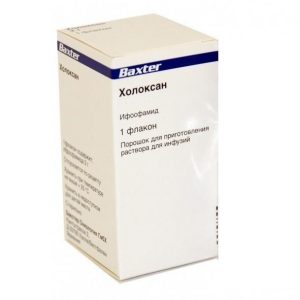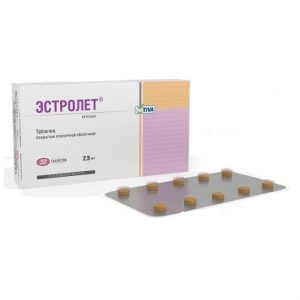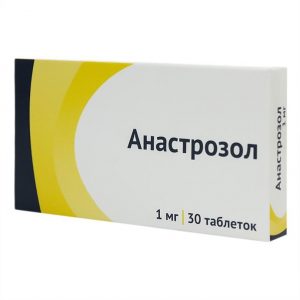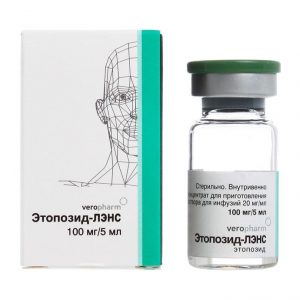Description
Pharmacological action
Selective non-steroidal aromatase inhibitor. It has antitumor activity against estrogen-dependent breast tumors in postmenopausal women. Reduces the content of circulating estradiol. It does not have progestogenic, androgenic and estrogenic activity, does not affect the secretion of endogenous glucocorticosteroids (GCS) and mineralocorticoids (ISS).
Pharmacokinetics:
Absorption – high (after ingestion, 83 – 85% of the dose taken is absorbed), maximum concentration (Tcmax) -2 hours. Communication with plasma proteins – 40%. About 90 – 95% of the constant plasma concentration is reached after 7 days of taking the drug. There is no information on cumulation.
Well metabolized in postmenopausal women. Metabolism is carried out in the process of N-dealkylation, hydroxylation and conjugation with glucuronic acid. The main metabolite, triazole, which is determined in plasma and urine, does not inhibit aromatase. The elimination half-life (T1 / 2) is 50 hours. Metabolites are excreted mainly by the kidneys, less than 10% of the dose is excreted in the urine unchanged for 72 hours.
Anastrozole clearance after oral administration in volunteers with stabilized liver cirrhosis or impaired renal function does not differ from clearance determined in healthy volunteers.
Indications
– Adjuvant therapy of early breast cancer, with positive hormone receptors in postmenopausal women, including after adjuvant therapy with tamoxifen for 2-3 years.
– The first line of treatment for locally advanced or metastatic breast cancer, with positive or unknown hormone receptors in postmenopausal women.
– The second line of therapy for advanced breast cancer progressing after treatment with tamoxifen in postmenopausal women.
Contraindications
Hypersensitivity to anastrozole or other components of the drug, estrogen-dependent breast tumors in women in the premenopausal period, severe liver failure (safety and effectiveness have not been established), concomitant therapy with tamoxifen or drugs containing estrogen, children’s age (safety and efficacy not established).
Precautions:
Osteoporosis, hypercholesterolemia, coronary heart disease (CHD), impaired liver function, severe renal failure (creatinine clearance (CC) less than 20 ml / min).
Additionally for dosage forms containing lactose: lactase deficiency, lactose intolerance, glucose-galactose malabsorption.
Special instructions
In women with an estrogen receptor-negative tumor, the efficacy of anastrozole has not been demonstrated, unless there has been a previous positive clinical response to tamoxifen.
In case of doubt about the hormonal status of the patient, menopause should be confirmed by the determination of sex hormones in the blood serum.
Drugs containing estrogen should not be prescribed simultaneously with anastrozole, because they will level the pharmacological effect of anastrozole. The effectiveness and safety of anastrozole and tamoxifen when used simultaneously, regardless of the status of hormonal receptors, are comparable to those when using tamoxifen alone. The exact mechanism of this phenomenon is still unknown.
In the case of persistent uterine bleeding while taking anastrozole, consultation and observation by a gynecologist is necessary.
By lowering the level of circulating estradiol, anastrozole may cause a decrease in bone mineral density.
In patients suffering from osteoporosis or at risk of developing osteoporosis, bone mineral density should be assessed by densitometry (for example, DEXA scanning – dual energy X-ray absorptiometry) at the beginning of treatment and in dynamics. If necessary, treatment or prevention of osteoporosis should be initiated under close medical supervision. At the moment, there are insufficient data on the positive effect of bisphosphonates on the loss of bone mineral density caused by anastrozole, or their benefits when used for prophylaxis.
There is no data on the simultaneous use of anastrozole and analog preparations of gonadotropin releasing hormone (GnRH).
It is not known whether anastrozole improves treatment outcomes when used together with chemotherapy.
Impact on the ability to drive transp. Wed and fur .:
Some side effects of anastrozole, such as asthenia and drowsiness, can adversely affect the ability to perform potentially dangerous activities that require increased concentration of attention and speed of psychomotor reactions. In this regard, it is recommended that when these symptoms appear, caution is required when driving vehicles and mechanisms.
Composition
Composition per tablet:
Active ingredient: Anastrozole 1.0 mg
Excipients
Lactose monohydrate 65.0 mg
Microcrystalline cellulose 25.0 mg
Carboxymethyl starch mggld 5 mg mg srld 5 mg sodium stearate 1.0 mg
Weight of the tablet core is 100.0 mg
Film coat: Aquarius Prime VAR218010 white 3.0 mg [hypromellose – 65%, titanium dioxide -25%, macrogol (polyethylene glycol) -10%]
Dosage and administration
Inside, at the same time, regardless of food intake, 1 mg once a day. The tablet should be swallowed whole, washed down with water. The duration of treatment depends on the form and severity of the disease (with adjuvant therapy, the recommended duration of treatment is 5 years). If signs of disease progression appear, the drug should be discontinued.
Impaired renal function: dose adjustment in patients with mild to moderate renal failure is not required. In patients with severe renal failure, the drug should be used with caution.
Impaired liver function: dose adjustment in patients with mild to moderate hepatic impairment is not required.
Side effects
The frequency of adverse reactions listed below determined according to the following criteria: very often (at least 1/10) often (more than 1/100, less than 1/10) infrequently (more than 1/1000, less than 1/100) rarely (more than 1/10000, less than 1/1000) very rarely (less than 1/10000), including individual messages.
From the vessels: very often – flushing of the face.
From the side of musculoskeletal and connective tissue: very often – arthralgia / stiffness of joints, arthritis often – bone pain, myalgia infrequently – trigger finger.
From the genitals and mammary gland: often – dryness of the vaginal mucosa, vaginal bleeding (mainly during the first weeks after cancellation or change of previous hormone therapy to anastrozole).
From the skin and subcutaneous tissues: very often – skin rash often – thinning hair, alopecia, allergic reactions infrequently – urticaria rarely – erythema multiforme, anaphylactoid reaction, skin vasculitis (including some cases of purpura (Shenlein-Genoch syndrome)) very rarely Stevens-Johnson syndrome, angioedema.
From the gastrointestinal tract: very often – nausea often – diarrhea, vomiting.
On the part of the liver and biliary tract: often – increased activity of alkaline phosphatase, alanine aminotransferase (ALT), aspartate aminotransferase (ACT), rarely increased activity of gamma-glutamyl transferase and bilirubin concentration, hepatitis.
On the part of the nervous system: very often – headache often – drowsiness, carpal tunnel syndrome (mainly observed in patients with risk factors for this disease), sensitivity disorders (including paresthesia, loss or perversion of taste).
From the side of metabolism and nutrition: often – anorexia, hypercholesterolemia infrequently – hypercalcemia (e / without reducing the concentration of parathyroid hormone). Taking the drug can cause a decrease in bone mineral density due to a decrease in the concentration of circulating estradiol, thereby increasing the risk of osteoporosis and bone fractures.
General disorders: very often – asthenia of mild or moderate severity.
Adverse events noted during clinical trials that are not related to taking anastrozole: anemia, constipation, dyspepsia, back pain, abdominal pain, increased blood pressure, increased body weight, depression, insomnia, dizziness, anxiety, paresthesia.
Overdose of
A single dose of anastrozole, which could lead to life-threatening symptoms, has not been established. Treatment: induction of vomiting, dialysis, maintenance therapy, monitoring the function of vital organs and systems. There is no specific antidote.
Storage conditions
In a dry, dark place at a temperature of no higher than 25 ° C.
Keep out of the reach of children.
Expiration
2 years.
Do not use the product after the expiration date indicated on the package.
Active ingredient
Anastrozole
Terms and conditions
prescription
dosage form
tablets
Appointment
Adult prescription
Indications
Onkolohycheskye disease, breast cancer gland




